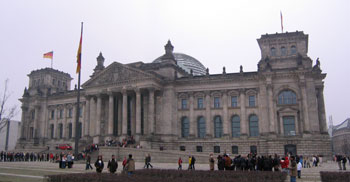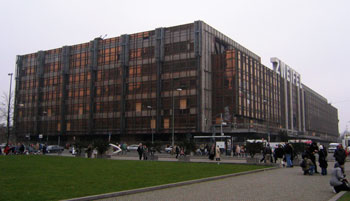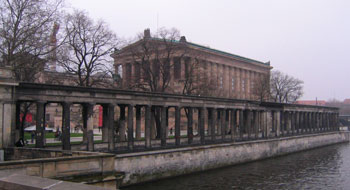 |
| The refurbished Reichstag building (Click to enlarge) |
Our first afternoon on arrival was spent checking out the world famous Pergamon museum on the very impressive Museum Island (which is a world heritage site). The Pergamon Museum is the German equivalent to the British Museum on a slightly smaller scale. It focuses on a couple of Greek/Roman/Islamic sites but does so on a grand scale. The museum has two complete walls from the city of Babalyon, (each a couple of 100m long and 20m high) but only one wall is on display plus a very large Roman temple. I found the Pergamon Museum better than the British Museum in that it did not put so much stuff on display but rather focused on a concise selection. This made appreciating and comprehending the relics dating back thousands of years far easier.
 |
| Museum Island |
The next morning we took part in a four hour guided walking tour of central Berlin by Insider Tours. Our guide was a 20-something architect from London and there was probably 40 people on the tour. He handled the group well and made the tour highly enjoyable. Whilst we were on our feet for almost four hours (with a 30 minute lunch break) it did not feel that long as we were constantly being shown or told fascinating things about Berlin and its history. It turns out that the majority of central Berlin was located on the eastern side of the Wall and that there are three distinguishing features between west and east Berlin:
1. Little traffic man - The character on pedestrian traffic light signs.
2. Trams are only in the former East Berlin.
3. Most buildings in the east have been built cheaply using prefabricated concrete systems in order to keep up with the rebuilding taking place in the western half between 1960-1980.
The last two features are a bit boring but we all found the Little Traffic Light Man to be great due to his crazy walking style. He has become a bit of a cult icon in Berlin in recent times and there is lots of merchandising associated with him (http://www.ampelmann.de/). To get into the act I bought a t-shirt and fridge magnets with him on.
Our tour covered all the significant sights in the central city from the Reichstag to the Berlin Wall and Checkpoint Charlie. All where very good except for Checkpoint Charlie which has become a bit of a Disneyland attraction (complete with fake wall, checkpoint and guards). There has been a staggering amount of building throughout Berlin which has left the city almost 50 billion Euros in debt. Even after all this construction there is still signs of the battle between Germans and Russians for the streets of Berlin in April 1945.
 |
| The old East German Debating Chamber |
One of the last and strangest buildings on the tour was the Communist era debating chamber in the central square. Built to signify the open nature of East German politics (which in reality where far from open) the building not only housed debating chambers and offices but a bowling alley, restaurants and nightclubs for the public. After unification it was abandoned and partially torn down. Then the Berlin city council ran out of money so the derelict building now stands empty apart from the occasional art display. The word zweifel on the facade is a recent art installation and is German for doubt. This represents not only the uncertain nature of the building but also the city of Berlin as it moves into an uncertain future.
After the tour ended we went back through a few places that we rushed past on the tour in order to take a closer look. Afterwards we returned to the hostel feeling very tired after experiencing such an abundance of new things and doing so much walking.
More photographs from Berlin...
The Next Day: Exploring Berlin's Sights
erlin
